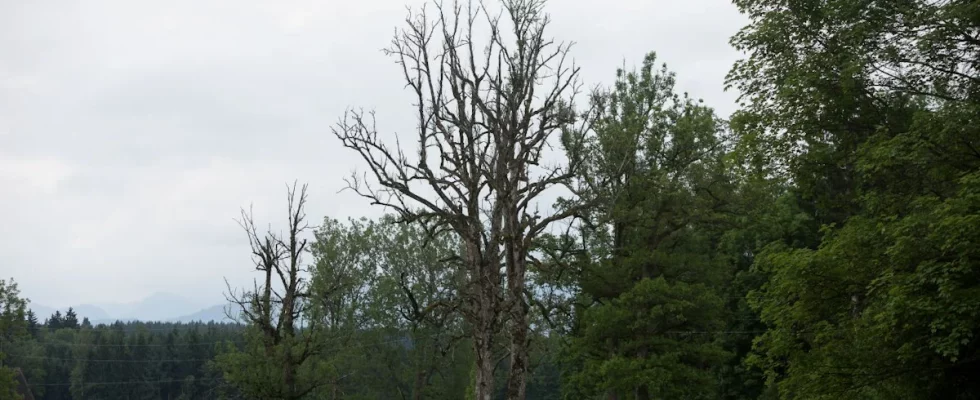Ash shoot dieback has been troubling foresters and forest owners in Bavaria for 16 years. The tree disease, which was first detected in the Free State in 2008, has the potential to decimate the ash trees in this country to such an extent that the tree species is unlikely to play any role in Bavaria. But now there is hope that things will turn out differently. The Office for Forest Genetics (AWG) in Teisendorf, Upper Bavaria, has created a plantation with young ash seed trees in a forest near Lake Waginger (Traunstein district). AWG boss Joachim Hamberger and his employees expect that their descendants will one day be resistant to ash shoot dieback.
Forestry Minister Michaela Kaniber (CSU), who is responsible for the Office for Forest Genetics, is also optimistic. “We are securing the future of the ash tree in our forests,” said Kaniber as she toured the plantation on Monday. “This is an important step, especially in times of climate change. Ash is a real all-rounder. It is drought-tolerant, ecologically very valuable and provides a versatile wood.” The AWG is part of the Bavarian Forestry Administration; the institution not only researches native and other tree species, but also produces seeds in a number of plantations. In times of the climate crisis, which is massively affecting the forests in the Free State, the AWG takes on particular importance.
Ash trees can grow up to 40 meters high and have a trunk diameter of up to two meters. The bark of young trees is yellowish gray and smooth for a long time; as the ash trees get older, their bark becomes longitudinally cracked. The foliage is opposite, pinnate and serrate at the edges. Ash trees, whose wood is of very high quality and can be processed in a variety of ways, are nowhere near as common as beech or oak trees. Experts estimate their share of the tree species mix in Bavaria to be just three percent. Larger populations are only found in the riparian forests along the rivers, but also in swamp and ravine forests. Because the ash tree likes it moist.
Just twenty years ago, many foresters and forest owners had high hopes for Fraxinus excelsior, the scientific name of the deciduous tree species. The ash tree copes well with hot, dry periods, which are becoming increasingly common in Bavaria during the climate crisis. It has now even been shown that the ash tree resists climate change significantly better than the beech tree, which climate experts among foresters have relied on for a long time.
But then the death of ash shoots suddenly dashed the previous expectations. In the fall of 2008, forest owners discovered the then new tree disease in a number of forests throughout Bavaria. When ash shoots die, the foliage of the affected trees first becomes sparse, then entire branches dry up and ultimately the trees die completely – the disease progresses quickly in young ash trees, but can take a long time in old ones.
The pathogen is a fungus
The pathogen is the false white stem cup or Hymenoscyphus pseudoalbidus. This is a fungus whose spores fly from tree to tree with the wind and which migrated from Poland. Four fifths of Bavaria’s ash trees are now believed to have fallen victim to ash shoot dieback. The false white stem cup is originally native to Japan and came to Europe as a result of globalization. The tricky thing is that the Hymenoscyphus pseudoalbidus does not differ externally from the long-known white stem cup (Hymenoscyphus albidus). This is a harmless native fungus that decomposes fallen ash leaves.
Of course, ash shoot dieback is not only rampant in Bavaria. But throughout Germany and Central Europe. That’s why a number of relevant research institutions in Germany set up the “FraxForFuture” joint project years ago. “The aim is not only to research ash shoot dieback, but above all to develop effective counter-strategies so that the tree species can be preserved here,” says AWG boss Hamberger, whose office is of course part of the association. The approximately two hectare ash plantation with its almost 670 seed trees near Lake Waginger is a first concrete success in the fight against the deadly tree disease.
Of course, it was a long way before the plantation could be established. At the beginning there was a search of the riparian forests in Bavaria for vital old ash trees. “It quickly became apparent that some ash trees are obviously immune to the aggressive fungus,” says Hamberger. “So we systematically looked for them.” An indication of an ash tree’s immunity is that it stands lush green among diseased or dead ash trees without any evidence of infestation.
The grafts were treated with the fungus
“We got grafts from trees like these,” says Hamberger, i.e. vital branches that had all the potential to one day become good seed trees. “The scions were then treated with the fungus. Be it directly through the leaves of infected ash trees or by scratching its spores under the bark with a scalpel.” Two thirds of the grafts survived the procedure undamaged. The almost 670 young trees for the seed plantation were grown from them. According to Hamberger, it will of course still be ten to 15 years before they supply a significant number of seeds for ash trees that are resistant to the false white stem cup.
The opening of the ash seed orchard was also the start of the new AWG program “100 seed orchards for Bavaria”. It aims to quickly double the number of seed orchards in Bavaria to 100 in order to improve the supply of high-quality propagating material to tree nurseries and forest owners. “Good seeds cannot be worth their weight in gold for the success of forest conversion,” says Forestry Minister Kaniber. To implement the program, the AWG wants to enter into collaborations with the Bavarian State Forests and municipal forest owners in the next few months.

